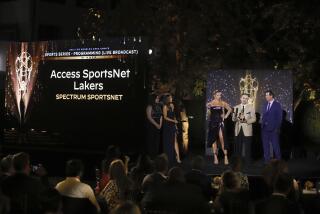Network casts wider net for events
- Share via
Talk about big shoes to fill.
If its name -- the World Championship Sports Network -- isn’t grand enough, consider the small, Los Angeles-based company’s goal of becoming a 21st century version of Roone Arledge’s revered “Wide World of Sports” program.
It’s too early to tell whether WCSN is heading toward the thrill of victory or the agony of defeat. But executives at the start-up company are confident that they can turn a profit by showcasing the Rodney Dangerfields of Olympic-style sports -- think skiing, fencing, badminton and gymnastics -- when the actual Olympic Games aren’t in session.
So far, WCSN has signed up about 10,000 subscribers, who pay $4.95 per month or $49.95 per year, to watch events streamed via the Internet. But WCSN Chairman Claude Ruibal will have to produce dramatic subscription growth before advertisers take notice.
WCSN is using digital technology advances that make it easier and cheaper to produce sports programming for distribution via the Internet, cable television, video on demand and whatever technology tomorrow brings. It hopes to draw support from fans frustrated by big media’s penchant for turning a blind eye to sports that play to packed houses overseas.
The U.S. Olympic Committee, which also is considering launching a 24-hour sports channel, maintains that 12 million fans of Olympic-style sports are hungry for the opportunity to see more of the events that rarely crack network and cable shows.
But WCSN faces considerable hurdles even if the USOC doesn’t leave the starting blocks.
WCSN is prohibited from streaming summer and winter Games because NBC pays hefty rights fees to the International Olympic Committee. The USOC also has a lock when it comes to profiting from the Olympic “brand” in this country -- and it also controls a massive library of video from past Olympic Games.
Ruibal, though, maintains that “we don’t want the Olympic rings, and we don’t need the Olympic rings.”
Instead, he’s banking on sports programming that isn’t being distributed in this country. In 2006, WCSN offered 2,000 hours of programming that featured top athletes in world-class competitions. The network will add more hours in 2007. Almost all of that video was produced by other parties, making the ready-made programming a fraction of what it would cost to dispatch crews around the world.
WCSN also is forging relationships with national sports governing bodies. The U.S. Ski Assn. buys time on NBC to ensure that a broader audience will see some of its races. But the typical downhill event lasts just under two hours, and after commercials, television viewers get only 42 minutes of skiing.
So the ski group recently signed a deal that allows WCSN to stream many of its races from start to finish. “And that creates so much more exposure for skiers, the sports, manufacturers and sponsors,” said Ted Morris, vice president of sales and marketing for the USSA.
Ditto with swimming. WCSN teamed up with USA Swimming last summer on start-to-finish coverage of the U.S. National Championships meet in Irvine and offers other races online.
“We absolutely love being on NBC, but, financially, that’s not possible for every meet,” said Matt Ferrell, director of business development for USA Swimming. “So, for us, being on a place like WCSN is a good alternative.”
WCSN has its own stable of announcers, including such former Olympians as gymnasts Nadia Comaneci and Bart Connor, high jumper Dwight Stones and snowboarder Kevin Delaney.
Ruibal won’t discuss specifics, but the network hopes to announce some cable deals next year that will make WCSN available in major media markets.
But some in the television and advertising industries have doubts about WCSN. Big networks measure viewers by the millions, one sports marketing insider said, which means WCSN faces an uphill fight to gain credibility with advertisers.
The daunting challenge of starting a network doesn’t seem to faze the USOC, which thinks its well-known brand from Olympics past gives it a solid foundation.
“We think the viewing public is going to want to go to a place where they can see a very high-level competition in a number of sports,” USOC Chairman Peter Ueberroth said. “We want to feature all the Olympic sports, from those that are not very popular in this country right now to those that are very popular -- as well as those that might one day become Olympic sports.”
The USOC views a sports network as a means of promoting sports, and the advertising dollars and subscription fees could serve as a source of new revenue to help finance athlete development.
Overseas sports federations also are looking to the Internet to get more of their games noticed. “We’re starting to talk to the federations about how to go about doing it,” said Peter Vickers, a spokesman for Eurovision, which distributes sports programming around the world.
Major League Baseball’s Advanced Media operation, which runs all of professional baseball’s digital businesses, already operates the Ice Channel, an Internet streaming operation for U.S. figure skating. It also took an equity stake in WCSN and handles the network’s Internet operations.
Sports marketers say it might make sense for WCSN to find a strategic partner -- say, a TV network -- to help steer viewers from televised events to the website for additional, in-depth coverage. Or it might turn out that the niche business isn’t big enough for both WCSN and USOC.
Bob Bowman, the chief executive of baseball’s Advanced Media unit who has pushed baseball to put its game in every medium available, sees a bright future for the specialized sports channels.
“The market right now is embryonic, and it’s going to grow,” Bowman said.
“What WCSN is doing makes great sense. So does the Ice Network and what the USOC is considering. At this point, who knows what the future is going to look like?”
*


